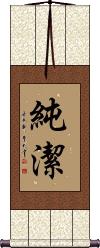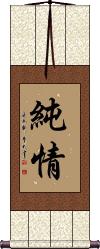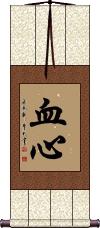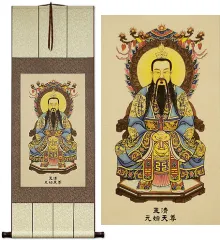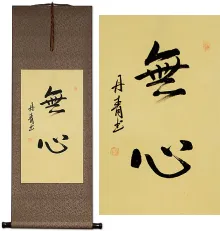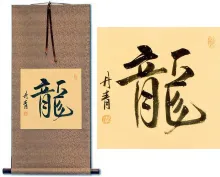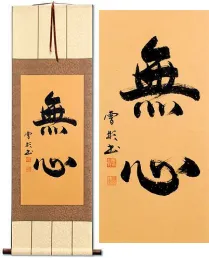Many custom options...
And formats...

The name Pure Heart in Chinese / Japanese...
Buy a Pure Heart calligraphy wall scroll here!
Personalize your custom “Pure Heart” project by clicking the button next to your favorite “Pure Heart” title below...
Chastity / Pure Heart
Also: Clean / Innocent / Pure
純潔 is associated with “chastity” but with the direct meaning of clean, innocent, and pure.
If you were expressing the idea of a “pure heart” in Chinese, while not literal, this would be the word you would use.
In Japanese, this word is sometimes used to express purity.
In Korean, it describes purity, chastity, virginity, and innocence (basically the same as the Chinese definition).
Pure Heart
Pure and Innocent
純情 means “Pure Heart” in Chinese, Japanese Kanji, and old Korean Hanja.
It's used to reflect the ideas of being “pure and innocent.”
Depending on the context in which this title is used, it can relay “self-sacrificing devotion” or, in some cases, “naïveté.”
This would be in the same way we might refer to a young girl giving her lunch money to a beggar on the street. She has a pure and precious heart but perhaps is also a bit naive.
Sincere Heart
When you take 血心 apart, you find the sum is slightly different than the parts. The first character means blood, and the second means heart. It is important to note that for thousands of years, it was believed that your heart was both your soul and your mind in Asian culture. When you add blood to the heart, it is your whole being - the pure and clean dedication of your whole soul.
Most Chinese dictionaries define this as the sincerity of heart or a MEDICAL TERM!!!
Please think carefully before ordering this selection - it was only added as others have used this for coffee cups and other novelties (though perhaps naively).
This in-stock artwork might be what you are looking for, and ships right away...
Gallery Price: $268.00
Your Price: $148.88
Gallery Price: $79.00
Your Price: $43.88
Not the results for pure heart that you were looking for?
Below are some entries from our dictionary that may match your pure heart search...
| Characters If shown, 2nd row is Simp. Chinese |
Pronunciation Romanization |
Simple Dictionary Definition |
布施 see styles |
bù shī bu4 shi1 pu shih fuse ふせ |
More info & calligraphy: Dana: Almsgiving and Generosity(n,vs,vi) (1) {Buddh} alms-giving; charity; (n,vs,vi) (2) {Buddh} offerings (usu. money) to a priest (for reading sutras, etc.); (surname) Fuho dāna 檀那; the sixth pāramitā, almsgiving, i. e. of goods, or the doctrine, with resultant benefits now and also hereafter in the forms of reincarnation, as neglect or refusal will produce the opposite consequences. The 二種布施 two kinds of dāna are the pure, or unsullied charity, which looks for no reward here but only hereafter; and the sullied almsgiving whose object is personal benefit. The three kinds of dāna are goods, the doctrine, and courage, or fearlessness. The four kinds are pens to write the sutras, ink, the sutras themselves, and preaching. The five kinds are giving to those who have come from a distance, those who are going to a distance, the sick, the hungry, those wise in the doctrine. The seven kinds are giving to visitors, travellers, the sick, their nurses, monasteries, endowments for the sustenance of monks or nuns, and clothing and food according to season. The eight kinds are giving to those who come for aid, giving for fear (of evil), return for kindness received, anticipating gifts in return, continuing the parental example of giving, giving in hope of rebirth in a particular heaven, in hope of an honoured name, for the adornment of the heart and life. 倶舍論 18. |
白蓮 白莲 see styles |
bái lián bai2 lian2 pai lien byakuren びゃくれん |
More info & calligraphy: White Lotus(1) white lotus; (2) purity; pure heart; (given name) Byakuren (白蓮華); 分陀利 puṇḍarīka, the white lotus. |
精神 see styles |
jīng shen jing1 shen5 ching shen seishin / seshin せいしん |
More info & calligraphy: Spirit(1) mind; spirit; soul; heart; ethos; (2) attitude; mentality; will; intention; (3) spirit (of a matter); essence; fundamental significance; (given name) Seishin Vitality; also the pure and spiritual, the subtle, or recondite. |
純情 纯情 see styles |
chún qíng chun2 qing2 ch`un ch`ing chun ching junjou / junjo じゅんじょう |
More info & calligraphy: Pure Heart(noun or adjectival noun) pure heart; naivete; innocence |
佛月 see styles |
fó yuè fo2 yue4 fo yüeh butsu gatsu |
The Buddha-moon, Buddha being mirrored in the human heart like the moon in pure water. Also a meaning similar to 佛日. |
南無 南无 see styles |
nā mó na1 mo2 na mo namu; namo なむ; なも |
Buddhist salutation or expression of faith (loanword from Sanskrit); Taiwan pr. [na2 mo2] (conj,int) {Buddh} amen; hail; (surname) Namu namaḥ; Pali: namo; to submit oneself to, from to bend, bow to, make obeisance, pay homage to; an expression of submission to command, complete commitment, reverence, devotion, trust for salvation, etc. Also written 南牟; 南謨; 南忙; 那謨 (or 那模 or 那麻); 納莫 (or 納慕); 娜母; 曩莫 (or 曩謨); 捺麻(or捺謨), etc. It is used constantly in liturgy, incantations, etc., especially as in namaḥ Amitābha, which is the formula of faith of the Pure-land sect, representing the believing heart of all beings and Amitābha's power and will to save; repeated in the hour of death it opens the entrance to the Pure Land. |
圓覺 圆觉 see styles |
yuán jué yuan2 jue2 yüan chüeh engaku |
Complete enlightenment potentially present in each being, for all have 本覺 primal awareness, or 眞心 the true heart (e. g. conscience), which has always remained pure and shining; considered as essence it is the 一心 one mind, considered causally it is the Tathāgata-garbha, considered it is|| perfect enlightenment, cf. 圓覺經. |
心月 see styles |
xīn yuè xin1 yue4 hsin yüeh mizuki みづき |
(female given name) Mizuki Mind (as the) moon, the natural mind or heart pure and bright as the full moon. |
性心 see styles |
xìng xīn xing4 xin1 hsing hsin shōshin |
The perfectly clear and unsullied mind, i. e. the Buddha mind or heart. The Chan (Zen) school use 性心 or 心性 indifferently. |
淨心 净心 see styles |
jìng xīn jing4 xin1 ching hsin Jōshin |
The pure heart or mind, which is the original Buddha-nature in every man. |
潔い see styles |
isagiyoi いさぎよい |
(adjective) (1) manly; sportsmanlike; gracious; gallant; resolute; brave; (2) pure (heart, actions, etc.); upright; blameless; (3) (archaism) unsullied (e.g. scenery or object); pure; clean |
白心 see styles |
bái xīn bai2 xin1 pai hsin byakushin |
A clear heart or conscience. |
直心 see styles |
zhí xīn zhi2 xin1 chih hsin jikishin じきしん |
{Buddh} true and honest heart; pure heart; heart devoted to Buddhism; (female given name) Naomi Straightforward, sincere, blunt. |
蓮宮 莲宫 see styles |
lián gōng lian2 gong1 lien kung hasumiya はすみや |
(place-name) Hasumiya padmavimāna. Lotus-palace, the Pure Land of the saṃbhogakāya; also the eight-leaved lotus of the heart. |
道體 道体 see styles |
dào tǐ dao4 ti3 tao t`i tao ti dōtai |
The embodiment of truth, the fundament of religion, i.e. the natural heart or mind, the pure nature, the universal mind, the bhūtatathatā. |
二解脫 二解脱 see styles |
èr jiě tuō er4 jie3 tuo1 erh chieh t`o erh chieh to ni gedatsu |
Two kinds of deliverance, mukti or mokṣa: (1) (a) 有爲解脫 Active or earthly deliverance to arhatship; (b) 無爲解脫 nirvana-deliverance. (2) (a) 性淨解脫 The pure, original freedom or innocence; (b) 障盡解脫 deliverance acquired by the ending of all hindrances (to salvation). (3) (a) 慧解脫 The arhat's deliverance from hindrances to wisdom; (b) 具解脫 his complete deliverance in regard to both wisdom and vision 慧 and 定. (4) (a) 時解脫 The dull who take time or are slow in attaining to 定 vision; (b) 不時解脫 the quick or clever who take "no time". (5) (a) 心解脫 A heart or mind delivered from desires; (b) 慧解脫 a mind delivered from ignorance by wisdom. |
心清し see styles |
kokorokiyoshi こころきよし |
pure heart; heart free of evil |
法明道 see styles |
fǎ míng dào fa3 ming2 dao4 fa ming tao hōmyō dō |
The wisdom of the pure heart which illumines the Way of all Buddhas. |
淨心住 净心住 see styles |
jìng xīn zhù jing4 xin1 zhu4 ching hsin chu jōshin jū |
The pure heart stage, the third of the six resting-places of a bodhisattva, in which all illusory views are abandoned. |
潔よい see styles |
isagiyoi いさぎよい |
(irregular okurigana usage) (adjective) (1) manly; sportsmanlike; gracious; gallant; resolute; brave; (2) pure (heart, actions, etc.); upright; blameless; (3) (archaism) unsullied (e.g. scenery or object); pure; clean |
胎藏界 see styles |
tāi zàng jiè tai1 zang4 jie4 t`ai tsang chieh tai tsang chieh taizō kai |
Garbhadhātu, or Garbhakośa-(dhātu), the womb treasury, the universal source from which all things are produced; the matrix; the embryo; likened to a womb in which all of a child is conceived— its body, mind, etc. It is container and content; it covers and nourishes; and is the source of all supply. It represents the 理性 fundamental nature, both material elements and pure bodhi, or wisdom in essence or purity; 理 being the garbhadhātu as fundamental wisdom, and 智 acquired wisdom or knowledge, the vajradhātu. It also represents the human heart in its innocence or pristine purity, which is considered as the source of all Buddha-pity and moral knowledge. And it indicates that from the central being in the maṇḍala, viz. the Sun as symbol of Vairocana, there issue all the other manifestations of wisdom and power, Buddhas, bodhisattvas, demons, etc. It is 本覺 original intellect, or the static intellectuality, in contrast with 始覺 intellection, the initial or dynamic intellectuality represented in the vajradhātu; hence it is the 因 cause and vajradhātu the 果 effect; though as both are a unity, the reverse may be the rule, the effect being also the cause; it is also likened to 利他 enriching others, as vajradhātu is to 自利 enriching self. Kōbō Daishi, founder of the Yoga or Shingon 眞言 School in Japan, adopted the representation of the ideas in maṇḍalas, or diagrams, as the best way of revealing the mystic doctrine to the ignorant. The garbhadhātu is the womb or treasury of all things, the universe; the 理 fundamental principle, the source; its symbols are a triangle on its base, and an open lotus as representing the sun and Vairocana. In Japan this maṇḍala is placed on the east, typifying the rising sun as source, or 理. The vajradhātu is placed west and represents 智 wisdom or knowledge as derived from 理 the underlying principle, but the two are essential one to the other, neither existing apart. The material and spiritual; wisdom-source and intelligence; essence and substance; and similar complementary ideas are thus portrayed; the garbhadhātu may be generally considered as the static and the vajradhātu as the dynamic categories, which are nevertheless a unity. The garbhadhātu is divided into 三部 three sections representing samādhi or quiescence, wisdom-store, and pity-store, or thought, knowledge, pity; one is called the Buddha-section, the others the Vajra and Lotus sections respectively; the three also typify vimokṣa, prajñā, and dharmakāya, or freedom, understanding, and spirituality. There are three heads of these sections, i. e. Vairocana, Vajrapāṇi, and Avalokiteśvara; each has a mother or source, e. g. Vairocana from Buddha's-eye; and each has a 明王 or emanation of protection against evil; also a śakti or female energy; a germ-letter, etc. The diagram of five Buddhas contains also four bodhisattvas, making nine in all, and there are altogether thirteen 大院 or great courts of various types of ideas, of varying numbers, generally spoken of as 414. Cf. 金剛界; 大日; 兩部. |
卽心念佛 see styles |
jí xīn niàn fó ji2 xin1 nian4 fo2 chi hsin nien fo sokushin nenbutsu |
To remember, or call upon, Amitābha Buddha within the heart, which is his Pure Land. |
卽相卽心 see styles |
jí xiàng jí xīn ji2 xiang4 ji2 xin1 chi hsiang chi hsin sokusō sokushin |
Both form and mind are identical, e.g. the Pure Land as a place is identical with the Pure Land in the mind or heart—a doctrine of the Pure Land or Jōdo sect. |
本不生際 本不生际 see styles |
běn bù shēng jì ben3 bu4 sheng1 ji4 pen pu sheng chi hon pushō zai |
The original status of no rebirth, i. e. every man has a naturally pure heart, which 不生不滅 is independent of the bonds of mortality. |
清浄潔白 see styles |
seijoukeppaku / sejokeppaku せいじょうけっぱく |
(n,adj-na,adj-no) (yoji) upright and clean-handed; pure in heart and with a clean conscience |
純な少女 see styles |
junnashoujo / junnashojo じゅんなしょうじょ |
virgin; maiden pure in heart |
純一無雑 see styles |
junitsumuzatsu じゅんいつむざつ |
(n,adj-na,adj-no) (yoji) pure and unadulterated; pure in heart; simplehearted |
純情可憐 see styles |
junjoukaren / junjokaren じゅんじょうかれん |
(noun or adjectival noun) (yoji) pure of heart and pretty |
純真可憐 see styles |
junshinkaren じゅんしんかれん |
(noun or adjectival noun) (yoji) pure of heart and beautiful; innocent and beautiful |
純真無垢 纯真无垢 see styles |
chún zhēn wú gòu chun2 zhen1 wu2 gou4 ch`un chen wu kou chun chen wu kou junshinmuku じゅんしんむく |
pure of heart (noun or adjectival noun) (yoji) pure; purity |
Click here for more pure heart results from our dictionary
The following table may be helpful for those studying Chinese or Japanese...
| Title | Characters | Romaji (Romanized Japanese) | Various forms of Romanized Chinese | |
| Chastity Pure Heart | 純潔 纯洁 | jun ketsu / junketsu | chún jié / chun2 jie2 / chun jie / chunjie | ch`un chieh / chunchieh / chun chieh |
| Pure Heart | 純情 纯情 | jun jou / junjou / jun jo | chún qíng chun2 qing2 chun qing chunqing | ch`un ch`ing chunching chun ching |
| Sincere Heart | 血心 | xuě xīn / xue3 xin1 / xue xin / xuexin | hsüeh hsin / hsüehhsin | |
| In some entries above you will see that characters have different versions above and below a line. In these cases, the characters above the line are Traditional Chinese, while the ones below are Simplified Chinese. | ||||
Successful Chinese Character and Japanese Kanji calligraphy searches within the last few hours...
